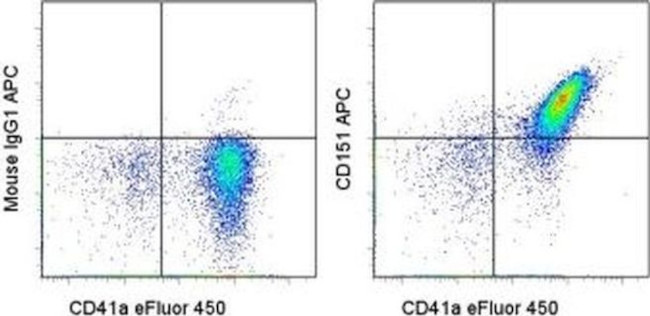Search Thermo Fisher Scientific
Invitrogen
CD151 Monoclonal Antibody (50-6), APC, eBioscience™
Product Details
17-1519-42
Species Reactivity
Published species
Host/Isotype
Recommended Isotype Control
Class
Type
Clone
Conjugate
Excitation/Emission Max
Form
Concentration
Purification
Storage buffer
Contains
Storage conditions
Shipping conditions
RRID
Product Specific Information
Description: The monoclonal antibody 50-6 recognizes human CD151 also known as PETA-3 (platelet-endothelial cell tetraspan antigen-3). CD151 has a molecular weight of 29 kDa and like other tetraspanin family members, CD151 contains four hydrophobic transmembrane domains, two short cytoplasmic tails, and one small and one large extracellular loop. CD151 is expressed on platelets, megakaryocytes, endothelial cells, at the cell-cell junctions, as well as epithelial cells where it localizes to basolateral surfaces exposed to extracellular matrix. The tetraspanins play a role in cell adhesion and migration; CD151 interacts with integrinalpha3 beta1 and integrinalpha6 beta4. In particular CD151 forms a functional complex with c-Met and integrin alpha3 and alpha6 in human salivary gland cancer cells. Additionally it can interact with CD46. Together these interactions are thought to play a role during early metastasis as a potential positive effector.
The 50-6 monoclonal antibody inhibits in vivo metastasis of a human epidermal carcinoma cell line, HEp-3.
Applications Reported: This 50-6 antibody has been reported for use in flow cytometric analysis.
Applications Tested: This 50-6 antibody has been pre-titrated and tested by flow cytometric analysis of human platelets. This can be used at 5 µL (0.125 µg) per test. A test is defined as the amount (µg) of antibody that will stain a cell sample in a final volume of 100 µL. Cell number should be determined empirically but can range from 10^5 to 10^8 cells/test.
Excitation: 633-647 nm; Emission: 660 nm; Laser: Red Laser.
Filtration: 0.2 µm post-manufacturing filtered.
Target Information
The protein encoded by this gene is a member of the transmembrane 4 superfamily, also known as the tetraspanin family. Most of these members are cell-surface proteins that are characterized by the presence of four hydrophobic domains. The proteins mediate signal transduction events that play a role in the regulation of cell development, activation, growth and motility. This encoded protein is a cell surface glycoprotein that is known to complex with integrins and other transmembrane 4 superfamily proteins. It is involved in cellular processes including cell adhesion and may regulate integrin trafficking and/or function. This protein enhances cell motility, invasion and metastasis of cancer cells. Multiple alternatively spliced transcript variants that encode the same protein have been described for this gene.
For Research Use Only. Not for use in diagnostic procedures. Not for resale without express authorization.
How to use the Panel Builder
Watch the video to learn how to use the Invitrogen Flow Cytometry Panel Builder to build your next flow cytometry panel in 5 easy steps.
Bioinformatics
Protein Aliases: CD 151; CD151; CD151 antigen; CD151 antigen (Raph blood group); CD151 molecule; GP27; hemidesmosomal tetraspanin CD151; Membrane glycoprotein SFA-1; PETA-3; platelet surface glycoprotein gp27; platelet-endothelial cell tetraspan antigen 3; Platelet-endothelial tetraspan antigen 3; Tetraspanin-24; Tspan-24
Gene Aliases: CD151; GP27; MER2; PETA-3; RAPH; SFA1; TSPAN24
UniProt ID: (Human) P48509
Entrez Gene ID: (Human) 977

Performance Guarantee
If an Invitrogen™ antibody doesn't perform as described on our website or datasheet,we'll replace the product at no cost to you, or provide you with a credit for a future purchase.*
Learn more
We're here to help
Get expert recommendations for common problems or connect directly with an on staff expert for technical assistance related to applications, equipment and general product use.
Contact tech support


